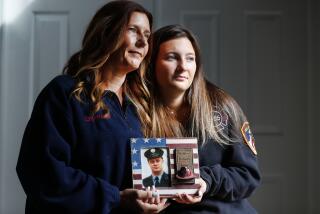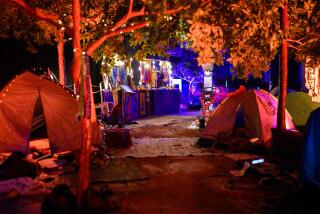Where the Towers Still Stand Tall
On the morning of Sept. 12, a visitor to San Diego’s Museum of Photographic Arts stopped to ask museum director Arthur Ollman why he and his staff were putting up pictures of Manhattan’s World Trade Center--photos that Ollman describes as artistic studies of the effect of light and weather on the Twin Towers, shot in the 1970s.
“I said: ‘Because of yesterday’s events,’” Ollman recalls. “And he said: ‘What happened yesterday?’ It was 24 hours later and he still had not heard--no television, no radio, no newspaper, nothing.”
It’s a safe guess that this unidentified man was the only person in the nation who found out about the Sept. 11 terrorist attacks from photographs in a museum, rather than through the immediate and overwhelming media images that appeared first on the TV screen, then frozen on the front pages of the next day’s newspapers.
He was, however, not the last person who will witness the effect of Sept. 11 on photo museums and galleries across the country in 2002.
Unlike other areas of the visual arts such as painting or sculpture, where the influence of Sept. 11 on artists and their exhibitions is expected to manifest itself in less literal ways, leaders of photo museums and galleries are already embracing Sept. 11 photography, both amateur and professional, as art--with several galleries, including Track 16 in Santa Monica’s Bergamot Station and the New-York Historical Society hosting benefit exhibitions of ground zero photographs on walls usually reserved for more conceptual works.
The onslaught of media photographs and video images in the larger world, they suggest, may translate into a revived artistic interest in documentary photography of all subjects, which will make itself felt on gallery walls in the coming year and beyond.
“Especially with documentary photography, there’s that wonderful line that’s always drawn--is it documentary or is it art?” says Tim B. Wride, associate curator of photography at the Los Angeles County Museum of Art and organizer of the museum’s 2001 exhibition “Shifting Tides: Cuban Photography After the Revolution.” “Those kinds of lines, to me, are very porous; you don’t have to live in an either-or world.
“I think what you see when something like this happens is perhaps there is a surge of documentary photography that begins to hit the galleries because we are image-conscious, in an image-devouring society, and the images we happen to be devouring at the moment happen to be documentary.
“That’s kind of a wave that you ride through. Then other images begin to reassert themselves.”
On the eve of 2002, the viewing public is still riding the wave, Ollman observes. “Television made [the attacks] as present to us as it was to someone on the Upper West Side,” he says. “Even if you couldn’t see it out your window or smell the air, you saw it on TV. I think that’s the way we’ve learned to experience the world. That’s the way we saw the Challenger disaster, the way that we walked on the moon.
“I think that the replay of those events, over and over again, gave us all the sensibility that we were close. And an interesting byproduct is, people have an almost insatiable appetite for the imagery.”
Adds Ollman: “When subject matter is so huge, and so profound, really, all you can do is show it. What are you going to do, hand-color it? You want to add neon lights? What can you do to make it any bigger than it was? It’s like pictures of an atomic bomb or something: The reality was so much stronger than any artistic statement that could be made from it.”
Aside from putting up the World Trade Center photos for a few days after the tragedy, the Museum of Photographic Art plans no exhibitions of photos specific to Sept. 11. But Ollman notes that visitors to the museum gift shop have snapped up architecture books and night lights that coincidentally featured photos of the World Trade Center. The museum even sold out a collection of lamps that featured the New York skyline.
From Nov. 10 to Dec. 8, Track 16 hosted “Here Is New York,” a collection of amateur photos mixed with professional shots. Photographers were invited to bring in or e-mail their photos, and the resulting collection was displayed in a storefront gallery in New York City. The exhibition will make its way to Chicago and other cities in the new year, with proceeds going to the Children’s Aid Society WTC Relief Fund.
And continuing through Feb. 25 is the New-York Historical Society’s “New York September 11 by Magnum Photographers,” an exhibition of photos from the book of the same name, published in mid-November by powerHouse Books (some photos by Magnum photographers were also part of “Here Is New York”). The Magnum exhibition also probably will travel after New York, although there are no specific plans yet. Among the photographers whose work is represented are Bruce Davidson, Josef Koudelka, Susan Meiselas, Paul Fusco and Eli Reed.
The photo collection resulted from a bizarre coincidence. On the night of Sept. 10, the photographers for the celebrated documentary photo agency Magnum, which provides photos for major news outlets, magazines and books around the world, were in New York City for their annual meeting. It ran until almost midnight: “Photographers like to talk,” explains Magnum director Nathan Benn.
As soon as the planes hit the towers, however, the photographers hit the streets. “Everybody did what they could do,” Benn says.
“Given that this horrible thing had to happen, we were fortunate that we had people with cameras who know what to do,” he continues. “A lot of our photographers have, in their careers, photographed combat, whether it’s Nicaragua, El Salvador or Afghanistan. Out of that they developed a self-discipline under very extreme circumstances.
“Within hours of the events, we were transmitting pictures to our clients in America and around the world. With so much very good photography from exceptional photographers, it seemed the natural thing to begin thinking about a book.
“We had no idea whether people would be interested in a book like this,” Benn adds. “That week, there was such a profusion of photography in the newspapers, it seemed cheeky to believe that there wouldn’t be fatigue about this very quickly.”
There wasn’t. On Nov. 16, 100,000 copies of the book were put on the shelves in bookstores across the country and sold out in 10 days, raising more than $400,000 for disaster relief. The publisher will issue another 50,000 copies in mid-January, and another of the same size later in the year.
The New-York Historical Society reports that attendance has tripled since the Magnum exhibition opened Nov. 20 (it runs though Feb. 25). Magnum is in discussions about touring the photos to other museums or galleries after the show closes in New York.
Benn says that many of the photographers featured in the New York book are now shooting in Afghanistan, and that Magnum plans a similar book of photos from that region, probably for next year. But the organization does not expect the book will sell anywhere near as many copies as the Sept. 11 book. “I think having a war come to your hometown wonderfully concentrates your mind on this in a way that a war on the other side of the world doesn’t,” he says.
In the upcoming year, Benn says, Magnum photographers working in New York will face the challenge of what to photograph next. “It’s a question that we’ve all asked ourselves, and I’m not satisfied with,” he says.
“I think that some of the projects that have been done after Sept. 11 verge or cross over into jingoistic patriotism,” he continues. “We understand where this comes from and share a lot of the values, but want to steer away from easy pictures of children waving American flags. We haven’t done studio pictures of the firemen. Some of those have been done very well, but we want to go beyond that, and we’re still searching as to how to come to grips with that.”
For the same reason, local photographer Merrick Morton--who, with his wife, Robin Blackman, owns Echo Park’s Fototeka gallery--says Fototeka will avoid doing a Sept. 11 exhibition in 2002.
In recent years, Fototeka has made its mark with displays of documentary photos from historical archives, including the popular “To Protect and Serve: The LAPD Archives,” on display during September and co-curated by Wride. A ground zero photo display would seem to be a natural. But “my personal feeling is, it could be exploitative,” Morton says. “I mean, there may be another wave, but at this point, it’s derivative. I don’t think the original idea was exploitative at all, but what else can you do?
“We don’t have all of our shows scheduled for 2002, but some of them are lighter themes. We have one called ‘Exotica,’ of Mexican glamour nudes from an archive from the late 1950s. I think it’s good for us, because it sort of takes people’s minds off it.”
Magnum’s Benn says that because Magnum is a documentary agency, Sept. 11 does not change the group’s mandate to cover the news.
But he is encouraged by an increased demand from magazines for photos of world events, rather than seductive shots of clothes, cars and celebrities. “It’s a very positive effect,” he says.
In 2002, Ollman hopes to see a similar value shift in the work of photographers who are not documentarians. “We’ve seen, over many years, a lot of high art that is sort of judged by the elegance of its cynicism,” he says.
“Sometimes it seems a little disingenuous to me for a lot of privileged, largely white art students to carry that sort of cynical, world-weary attitude, when in fact many other artists, working in countries where cynicism might be a more legitimate response to the environment, seem to work in a much greater tone of affirmation,” Ollman continues.
“We all saw something that would shake the cobwebs out of a sense of world-weariness, [a sense of] ‘we’ve seen it all.’ Well, we never saw this. Our sense of privilege, our sense of remove from the world has been irrevocably altered.”
*
Diane Haithman is a Times staff writer.
More to Read
The biggest entertainment stories
Get our big stories about Hollywood, film, television, music, arts, culture and more right in your inbox as soon as they publish.
You may occasionally receive promotional content from the Los Angeles Times.










